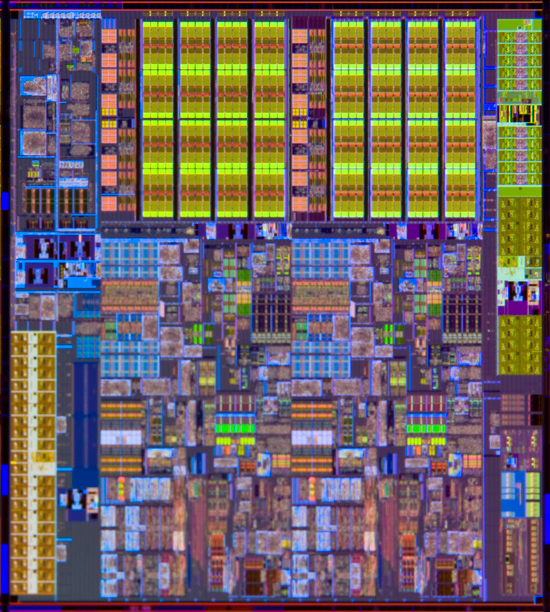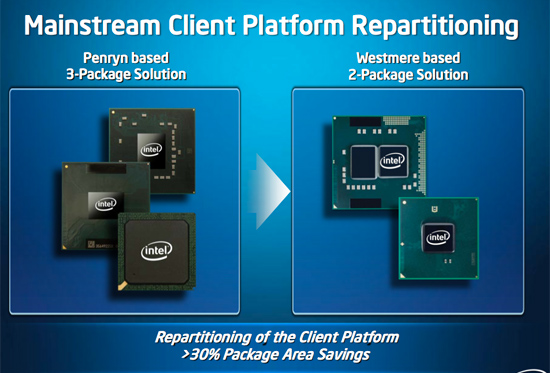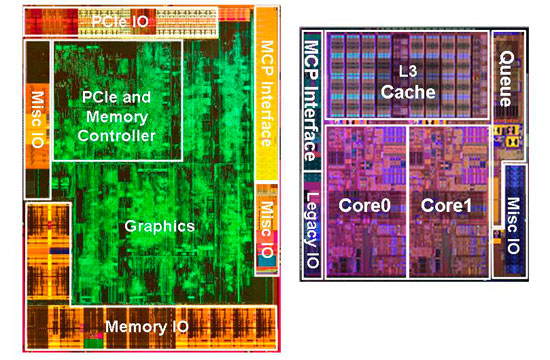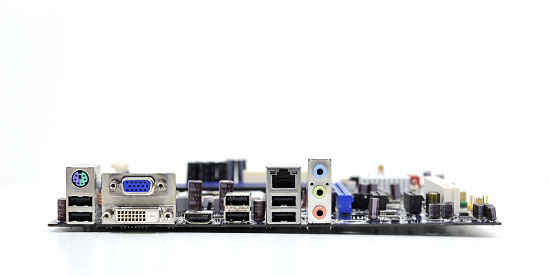The Clarkdale Review: Intel's Core i5 661, i3 540 & i3 530
by Anand Lal Shimpi on January 4, 2010 12:00 AM EST- Posted in
- CPUs
I swear this is the longest it’s taken for an Intel architecture to penetrate the market. We first met Nehalem on November 3rd, 2008. It came to us as a high end quad-core processor and took a full year to make it to more affordable motherboards in the form of Lynnfield. Even with P55 motherboard prices down at the magical $99 marker, Intel relinquished control of the $100 - $200 CPU market without a Nehalem to compete down there. Instead we were left with a choice between Penryn, the update to Intel’s 2006 Conroe architecture, or Phenom II, AMD’s low-cost Nehalem competitor. The choice was simple.
From $100 to $200, your best bet has been AMD. Either through aggressive pricing on quad-core CPUs or the L3-cache-less Athlon II line, AMD controls the $100 - $200 market. Today we meet Intel's first 32nm CPUs, codename Clarkdale, designed to specifically target that $100 - $200 market.

Two cores, Nehale..err Westmere-style
Technically Clarkdale isn’t Nehalem, it’s Westmere. Take Nehalem, use 32nm transistors, add in some new instructions for accelerating encryption/decryption, and you’ve got the makings of Westmere.
Clarkdale uses a dual-core Westmere and sticks it next to a 45nm Intel GMA die. That’s right, meet the first (er, second) Intel CPU with on-chip graphics. Next year we’ll see Sandy Bridge bring the graphics on-die, but until then we have Intel’s tried and true multi-chip-package to tide us over.

We don’t get on-die graphics yet because Intel still hasn’t switched over to its make-everything-at-the-best-process-ever strategy. The 32nm fabs are ramping up with CPU production and the 45nm fabs need something to do. Nearly every desktop and laptop sold in 2010 will need one of these 45nm GMA die, so the fabs indeed have something to do.
It’s not all rosy with Clarkdale unfortunately. Remember the memory controller that Nehalem so graciously integrated? Clarkdale kicks it off die again. The IMC is housed in the 45nm GMA die. It’s still on-package, but not on-die. The benefit is super fast memory access for the graphics core, but slower memory access for the CPU core. In fact, this is a derivative of the memory controller used in older Intel chipsets (e.g. P45/X48).

The CPU connects to the GMA die using QPI, so bandwidth shouldn’t be as big of a problem. Latency is unfortunately hurt as a result. Access times can be longer than older LGA-775 processors thanks to this memory controller design being optimized for FSB architectures. Again, the problem goes away with Sandy Bridge, but today we’re faced with it.
Like Lynnfield, Clarkdale uses Intel’s LGA-1156 socket. Clarkdale should work in all P55 motherboards, but you’ll need a BIOS update. No existing P55 motherboards route video from the socket to a VGA/DVI/HDMI connector, so you’ll need a new motherboard if you want to take advantage of the on-package graphics. Enter the H55, H57 and Q57 chipsets.

A typical H57 I/O layout
The H and Q-series of chipsets feature what Intel calls its Flexible Display Interface (FDI). This is basically a link between the CPU and the chipset that passes along video output. H5x/Q57 motherboards will have a video out on board so you can use Clarkdale’s integrated graphics.
The chipsets differ in price and features. The table below sums it up:
Support for Intel’s Rapid Storage Technology is probably the main reason you’ll want H57 over H55. The difference between H57 and Q57 boils down to security and management features. The H-series is for consumers, the Q-series is for corporate customers. Make sense?
The chips themselves are pretty straightforward. Intel is launching seven desktop Clarkdale processors (and a whole lot more notebook Arrandale chips):
| Processor | Core Clock | Cores / Threads | L3 Cache | Max Turbo | TDP | Price |
| Intel Core i5-670 | 3.46GHz | 2 / 4 | 4MB | 3.76GHz | 73W | $284 |
| Intel Core i5-661 | 3.33GHz | 2 / 4 | 4MB | 3.60GHz | 87W | $196 |
| Intel Core i5-660 | 3.33GHz | 2 / 4 | 4MB | 3.60GHz | 73W | $196 |
| Intel Core i5-650 | 3.20GHz | 2 / 4 | 4MB | 3.46GHz | 73W | $176 |
| Intel Core i3-540 | 3.06GHz | 2 / 4 | 4MB | N/A | 73W | $133 |
| Intel Core i3-530 | 2.93GHz | 2 / 4 | 4MB | N/A | 73W | $113 |
| Intel Pentium G9650 | 2.80GHz | 2 / 2 | 3MB | N/A | 73W | $87 |
The six processors labeled Core i5s and Core i3s all have the same basic architecture. You get per-core 256KB private L2s and you get a 4MB L3 cache shared among both cores (down from 8MB from the quad-core Lynnfield/Bloomfield chips). The i5s get turbo mode while the i3s do not. The i5-661 uses a higher graphics clock and has a higher TDP than the 660. Remember that these are CPU+GPU combos on a single package, so GPU clocks do vary based on model.

The Clarkdale lineup is honestly made up of CPUs that are too expensive. The Core i5 670, 661/660 and 650 are all priced above $170 and aren’t worth the money. The problem is Lynnfield’s turbo mode gives you high enough clock speeds with two threads that there’s no need to consider a dual-core processor. You can buy a Core i5 750, have more cores than any of these Clarkdales and run at close enough to the same frequencies for $196. Or you can buy a Phenom II X4 965 for about the same price and have much better multi-threaded performance. The chips that are most interesting are the Core i3s.
| Processor | Clock Speed | Max Turbo | |
| 2 Cores Active | 1 Core Active | ||
| Intel Core i5-670 | 3.46GHz | 3.60GHz +3.9% | 3.73GHz +7.7% |
| Intel Core i5-661 | 3.33GHz | 3.46GHz +4.0% | 3.60GHz +8.0% |
| Intel Core i5-660 | 3.33GHz | 3.46GHz +4.0% | 3.60GHz +8.0% |
| Intel Core i5-650 | 3.20GHz | 3.33GHz +4.2% | 3.46GHz +8.3% |
| Intel Core i3-540 | 3.06GHz | N/A | |
| Intel Core i3-530 | 2.93GHz | N/A | |
Turbo just isn't as interesting with only two cores. With four cores you used to have to make a tradeoff between good 4 and 2 threaded performance, but Lynnfield fixed that. No one really debates single vs. dual core anymore. The single core turbo modes are great, but aren't worth the money. Pay attention to the i3s.











93 Comments
View All Comments
Jamahl - Monday, January 4, 2010 - link
If this is a sign of things to come from intels 32nm, AMD must be laughing their asses off.Every one of these cpu's is an overpriced piece of garbage.
ereavis - Monday, January 4, 2010 - link
Phenom II X2 550 should be on this list, it's the direct competitor to the i3 -- dual core with real cache. It beats the Athlon II X4 processors and the Athlon II X2 don't even belong.ereavis - Monday, January 4, 2010 - link
blasted no edit function. The 550 is also about the same price point.Guess I didn't combine criticism with the fact that this review was exactly what I've been waiting for and very well written, I like the added IGP page as I'm sitting on a 785 IGP while discrete cards are in between releases. All of which may get passed on to my mom's dying Sempron if an I3 deal pops up.
Also minor correction, the Phenom II 925 is an X4. Where are the release dates?
SilentSin - Monday, January 4, 2010 - link
I second your question to Intel about the pricing of the 32nm i5 chips...who the hell is going to buy that? The i3's are looking pretty sweet as an alternative to an AMD HTPC platform at that low price point, though. March should make for an interesting competition once AMD launches their new RD890G (4350 based) chipsets. I'm guessing those will thoroughly trounce the GMA part on these chips as well as having quite a few features that the Intel HD stuff can't do, but at least Intel put something up that isn't completely laughable for once.Cogman - Monday, January 4, 2010 - link
x264 is NOT a codec. Let me repeat that, x264 is NOT a codec. It is an ENCODER. The video output from x264 is in the H.264 standard (or codec if you like).Saying that x264 is an alternative to H.264 is retarded. It isn't an alternative, it USES the H.264 standard. Its like trying to say that mySQL is an alternative to the Ansi SQL standard. It isn't an alternative, it is an implementation of it.
puffpio - Monday, January 4, 2010 - link
hahaha..that always gets on my nerves too!but you can take it as a compliment that x264's popularity is strong enough that people mistake it for h264..
people make the same mistake with divx, kleenex, qtip, xerox, etc...
Anand Lal Shimpi - Monday, January 4, 2010 - link
My apologies for sounding like a fool :-) I've updated the text. I just meant that it was an alternative to closed source H.264 encoders but my phrasing was absolutely horrendous for that purpose.Thanks for pointing out the error :)
Take care,
Anand
proneax - Monday, January 4, 2010 - link
I would like to see you measure the power consumption on the DH55TC using the integrated graphics.Legitreviews shows Idle/Load of 49/99W for the 661 in that setup.
Anand Lal Shimpi - Monday, January 4, 2010 - link
Agreed - I'll do it as soon as I'm back in the office. Just gotta survive CES :)Take care,
Anand
medi01 - Monday, January 4, 2010 - link
Dual core 3.3Ghz CPU + Radeon 5870 consuming only 110 watt at load???